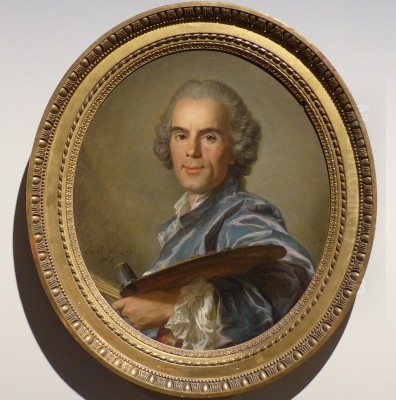
Claude-Joseph Vernet stands as one of the preeminent figures in 18th-century French art, a painter whose renown stretched across Europe. Born in Avignon in 1714 and passing away in Paris in 1789, Vernet's life spanned a period of significant artistic change. He became celebrated primarily for his evocative landscapes and, most notably, his dramatic seascapes, capturing the power, beauty, and terror of nature with unparalleled skill. His ability to render light and atmosphere, combined with a keen observation of the natural world, secured his place not only in the French Royal Academy but also in the collections of royalty and aristocracy throughout the continent.
Early Life and Artistic Formation in Avignon
Claude-Joseph Vernet's artistic journey began in the historic city of Avignon in the south of France. His initial training came from his father, Antoine Vernet (1689–1753), a competent, albeit modest, decorative painter. While Antoine provided his son with the foundational skills of the craft, it was clear that Claude-Joseph possessed a talent that required broader horizons. Recognizing his son's potential, Antoine encouraged him to seek further instruction.
In Avignon, the young Vernet continued his studies under local masters. He worked with Jacques Viali, a painter known for landscapes and seascapes, which likely sparked Vernet's early interest in these genres. He also studied with Philippe Sauvan (1697–1792), considered the leading painter in Avignon at the time. Sauvan specialized in religious commissions for churches and decorative mythological scenes for grand residences, offering Vernet exposure to large-scale composition and narrative painting, even if these were not the genres he would ultimately pursue with the same focus. This early education in Avignon provided Vernet with a solid technical grounding and an introduction to the artistic traditions of his region.
The Transformative Years in Italy
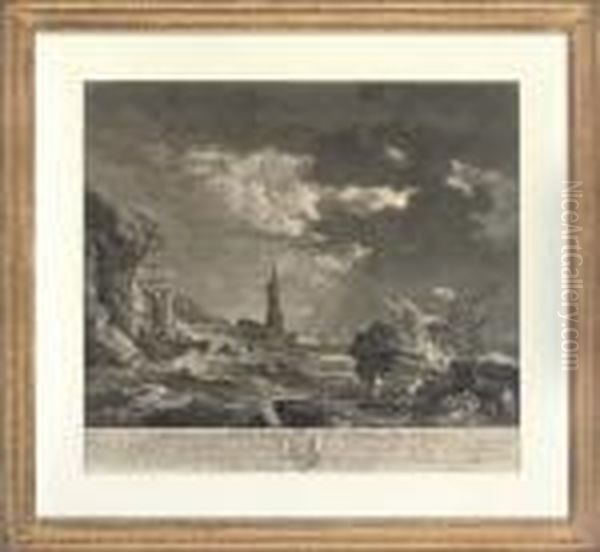
A pivotal moment in Vernet's development came in 1734 when, likely with the support and recommendation of figures like Sauvan and the patronage of Joseph de Seytres, Marquis de Caumont, he embarked on a journey to Rome. Italy, particularly Rome, was the essential destination for any ambitious European artist seeking to immerse themselves in the classical tradition and the works of the great masters. This trip, initially intended for historical painting studies, proved decisive in shaping his career towards landscape and marine art.
In Rome, Vernet sought out specialized training. He studied marine painting with Bernardino Fergioni and notably with Adrien Manglard (1695–1760), a French painter already established in Rome as a leading seascape artist. Manglard's influence was significant, refining Vernet's technique in depicting water, ships, and coastal light. Vernet also absorbed the influence of prominent Italian landscape painters. He studied the works of Giovanni Paolo Panini (1691–1765), famed for his vedute (view paintings) of Roman ruins and cityscapes, which likely honed Vernet's sense of architectural detail and perspective. He was also associated with Andrea Locatelli (1695–1741), another landscape specialist.
Beyond direct tutelage, Vernet immersed himself in the artistic environment of Rome. He deeply admired the work of the 17th-century French master Claude Lorrain (c. 1600–1682), whose idealized landscapes, bathed in golden light, became a lasting inspiration for Vernet's handling of atmosphere and luminosity. Equally important was the influence of the Italian Baroque painter Salvator Rosa (1615–1673), known for his wild, untamed landscapes and dramatic, often stormy, scenes. Rosa's sense of the sublime and the power of nature resonated strongly with Vernet's own inclinations. Vernet also spent time in Naples, further expanding his visual repertoire with the dramatic coastal scenery and bustling port life of Southern Italy. These Italian years were crucial, solidifying his focus and equipping him with a unique blend of French tradition and Italian dynamism.
Mastery of the Seascape
While adept at tranquil landscapes, Claude-Joseph Vernet became particularly famous for his dramatic marine paintings, especially his depictions of shipwrecks and storms. He possessed an extraordinary ability to capture the terrifying power and chaotic energy of the sea during tempests. His storm scenes are not mere topographical records; they are intense dramas exploring the fragility of human endeavors against the overwhelming forces of nature, a key theme of the emerging concept of the Sublime in art and literature.
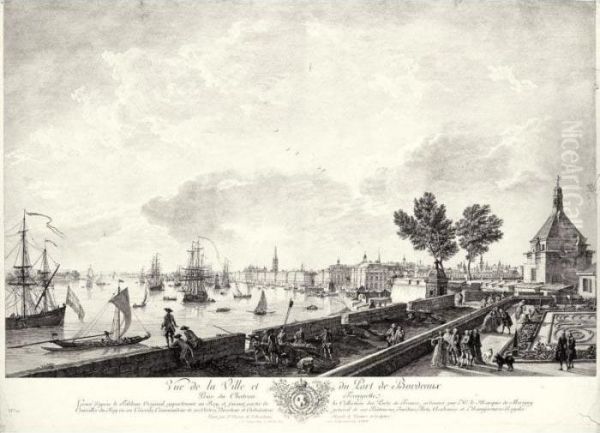
One of Vernet's most celebrated works in this genre is The Shipwreck (various versions exist). These paintings typically show vessels succumbing to mountainous waves under dark, turbulent skies, with desperate figures clinging to wreckage or struggling ashore. Vernet masterfully conveys the spray of the sea, the lashing rain, and the dramatic contrasts of light breaking through storm clouds. His meticulous rendering of rigging, sails, and the structure of ships, even in distress, adds a layer of convincing realism to these highly charged scenes.
A famous, perhaps apocryphal, anecdote illustrates Vernet's dedication to observing nature directly, even at personal risk. It is said that during a violent sea storm, he had himself tied to the mast of a ship so he could experience and study the tumultuous waves and atmospheric effects firsthand. Whether literally true or not, the story reflects his reputation for intense observation and his commitment to capturing the authentic feel of the maritime environment. This focus on direct experience and dramatic natural phenomena positioned him as a precursor to the Romantic movement that would flourish decades later, influencing artists like J.M.W. Turner.
Light, Atmosphere, and Idealization
A defining characteristic of Vernet's art, whether depicting calm harbors or raging storms, is his exceptional handling of light and atmosphere. He learned much from Claude Lorrain, particularly the technique of creating depth and mood through subtle gradations of light and color, often bathing his scenes in the warm glow of sunrise or sunset, or the cool, ethereal light of the moon. Vernet achieved a remarkable sense of aerial perspective, where distant objects appear softer and less distinct, convincingly suggesting vast spaces.
Vernet skillfully balanced realism with idealization. His depictions of ports, coastlines, and ships were based on careful observation, filled with accurate details of architecture, maritime activity, and human figures engaged in daily tasks or dramatic struggles. However, he often composed his scenes for maximum picturesque effect, arranging elements to create harmonious or dramatically compelling compositions rather than strictly adhering to topographical accuracy. This blend allowed his paintings to function both as recognizable views and as poetic evocations of place and mood.
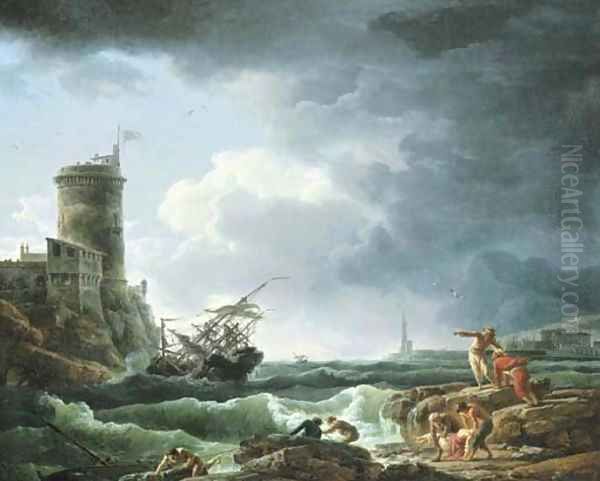
He frequently painted works in pairs or series, contrasting different times of day (morning, evening) or different weather conditions (calm, storm). A work like View of a Mediterranean Harbour (1747), depicting a serene port bathed in gentle light with figures calmly going about their business, provides a stark contrast to his tempestuous shipwreck scenes. This practice allowed patrons to appreciate the full range of his skills and explore different facets of the natural world and human experience within it. His ability to evoke specific atmospheric conditions – the clarity of Mediterranean air, the haze of morning mist, the oppressive humidity before a storm – was unparalleled among his contemporaries.
The Royal Commission: Ports of France
Vernet's reputation, built during his years in Italy and solidified upon his return to France, reached the highest levels of patronage. In 1753, he received a prestigious and demanding commission from King Louis XV, orchestrated through the Marquis de Marigny, the Director-General of the King's Buildings. The project was monumental: to paint a series of views depicting the major military and commercial ports of France. This commission was not merely artistic; it was a statement of national pride, intended to showcase the kingdom's maritime power, economic vitality, and the beauty of its coastlines during a period of intense rivalry with Great Britain.
Over the next decade, Vernet traveled extensively along the French coasts, from the Mediterranean to the Atlantic. He meticulously documented the specific features of each port – the fortifications, harbors, ships, local industries, and the daily life of the inhabitants. He aimed for accuracy but, as always, composed his views for aesthetic appeal, often incorporating elegant figures and picturesque details. The resulting series, Les Ports de France (The Ports of France), originally planned for around twenty canvases, ultimately comprised fifteen finished large-scale paintings by the time the project concluded around 1765 due to funding issues and the artist's exhaustion.
Works like Le port de Rochefort exemplify the series, showing the bustling naval arsenal with impressive ships under construction or repair, set against accurately rendered architecture and lively human activity. Other ports depicted included Marseille, Toulon, Bordeaux, Bayonne, and Dieppe. These paintings were highly acclaimed upon their exhibition at the Paris Salon. Today, the majority of this magnificent series is housed in the Musée du Louvre and the Musée National de la Marine in Paris, standing as a unique artistic and historical document of 18th-century France and a testament to Vernet's skill in handling complex, large-scale compositions filled with detail.
Return to Paris and Academic Recognition
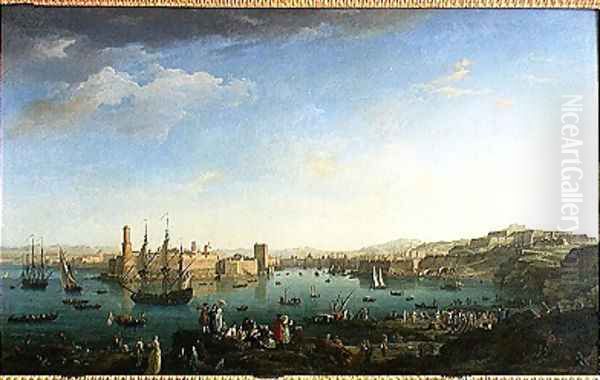
Having spent nearly two decades honing his craft and building his reputation in Italy, Vernet returned to France in 1753, summoned partly for the Ports of France commission. His arrival in Paris marked a new phase in his career, integrating him fully into the heart of the French art world. His Italian success preceded him, and he was quickly recognized by the establishment. Although some sources suggest an earlier acceptance, he was formally received into the prestigious Académie Royale de Peinture et de Sculpture (Royal Academy of Painting and Sculpture) in 1753, the same year he began the ports series. Membership in the Academy was the highest official recognition for an artist in France.
As an Academician, Vernet regularly exhibited his works at the Paris Salon, the official art exhibition that was crucial for an artist's reputation and commercial success. His paintings, particularly the ongoing Ports of France series and his captivating Italian landscapes and seascapes, were consistently praised by critics, including the influential Denis Diderot, although Diderot sometimes found his work repetitive later in his career. Vernet's Salon contributions solidified his position as France's leading landscape and marine painter.
In Paris, Vernet interacted with fellow artists. He had connections with Hubert Robert (1733–1808), another prominent landscape painter who also spent considerable time in Italy and specialized in picturesque views, often featuring ruins. While their styles differed – Robert focused more on architectural caprice and ancient ruins – they shared an interest in idealized landscapes derived from Italian scenery. Vernet's work was also seen in the context of other major French painters of the era, such as the Rococo master François Boucher (1703-1770) and the still-life and genre painter Jean-Baptiste-Siméon Chardin (1699–1779), though Vernet's specialization set him apart. He navigated the Parisian art scene successfully, maintaining his distinct artistic identity while achieving widespread acclaim.
International Acclaim and Patronage
Vernet's fame was by no means confined to France. His time in Italy had already established him as a desirable artist for international collectors, particularly British aristocrats undertaking the Grand Tour. These wealthy travelers were eager to acquire sophisticated souvenirs of their Italian sojourn, and Vernet's evocative landscapes and seascapes, capturing the beauty and drama of the Italian peninsula, were highly sought after. Many of his paintings entered important British collections during his lifetime.
His reputation continued to grow throughout Europe after his return to Paris. He received commissions from patrons across the continent, including royalty and nobility in England, Russia, Spain, and various German states. His ability to tailor his works, offering pairs depicting calm and storm, or series showing different times of day, appealed to collectors seeking decorative ensembles for their residences. Patrons appreciated his technical virtuosity, the emotional range of his work from serene to sublime, and the consistent quality of his output.
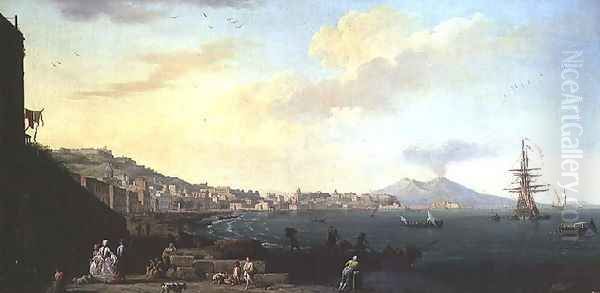
His patrons included figures like the Duc d'Orléans and potentially connections through diplomats like the French ambassador to Rome. The sheer volume of his production attests to his popularity and the efficiency of his studio practice. He became one of the most commercially successful painters of his time, his works commanding high prices. This international demand underscored the universal appeal of his art, transcending national borders and tastes, and cemented his status as a truly European artistic figure.
Later Career and Legacy
Claude-Joseph Vernet remained highly productive throughout his later career, even after completing the demanding Ports of France series. He continued to paint landscapes and seascapes, drawing on his Italian experiences and French observations, fulfilling numerous commissions for his eager international clientele. While some critics like Diderot occasionally noted a sense of formula in his later works, the demand remained strong, and he maintained a high level of quality and appeal. He continued exhibiting at the Salon until the 1780s.
Vernet's influence on the development of landscape painting was profound and lasting. He helped elevate landscape and marine painting to a higher status within the academic hierarchy, which had traditionally favored history painting. His emphasis on direct observation of nature, combined with his ability to convey powerful emotions and atmospheric effects, laid important groundwork for the Romantic landscape painters of the late 18th and early 19th centuries. Artists like Pierre-Henri de Valenciennes (1750–1819), a key figure in the development of neoclassical landscape and open-air sketching, certainly looked to Vernet's example.
His dramatic seascapes, particularly the storm scenes, resonated strongly with the Romantic fascination with the sublime and the power of nature. While direct influence is debated, the spirit of Vernet's work can be seen as anticipating the dramatic marine paintings of artists like Britain's J.M.W. Turner (1775–1851), who greatly admired dramatic natural effects. Vernet passed away in Paris in 1789, on the cusp of the French Revolution, leaving behind a vast body of work and a significant artistic legacy.
The Vernet Dynasty
Claude-Joseph Vernet was not only a highly successful artist himself but also the progenitor of a notable artistic dynasty that continued into the 19th century. His success provided a foundation and likely inspiration for his descendants. His son, Antoine Charles Horace Vernet, known as Carle Vernet (1758–1836), became a successful painter in his own right. Carle specialized in different genres, particularly battle scenes, equestrian subjects, and Orientalist themes, reflecting the changing tastes of the Napoleonic and Restoration periods. He was known for his spirited depictions of horses and military life.
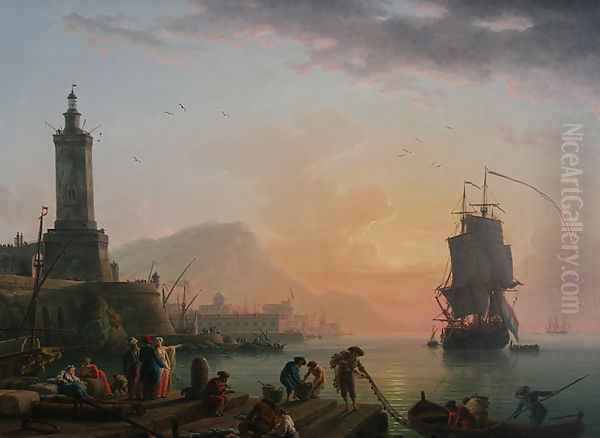
The artistic lineage reached its peak of fame with Claude-Joseph's grandson, Émile Jean-Horace Vernet, known simply as Horace Vernet (1789–1863). Horace became one of the most celebrated French painters of the 19th century, particularly renowned for his large-scale historical and military paintings. He enjoyed immense official patronage under various regimes, chronicling French military campaigns in North Africa and Europe. While his style and subject matter differed significantly from his grandfather's, the Vernet name remained synonymous with artistic achievement in France for over a century, a testament to the enduring legacy initiated by Claude-Joseph.
Conclusion: An Enduring Master
Claude-Joseph Vernet occupies a pivotal place in the history of European art. As France's foremost landscape and marine painter of the 18th century, he masterfully blended empirical observation with idealized composition. His depictions of the serene beauty of Italian landscapes, the bustling activity of French ports, and the terrifying grandeur of storms at sea captivated audiences across Europe. His unparalleled skill in rendering light and atmosphere, his contribution to the aesthetic of the Sublime, and his influence on subsequent generations of artists secure his importance. The monumental Ports of France series remains a unique achievement, while his numerous other works continue to be admired in museums and collections worldwide for their technical brilliance and evocative power. Vernet not only achieved immense success in his own time but also left an indelible mark on the tradition of landscape painting.